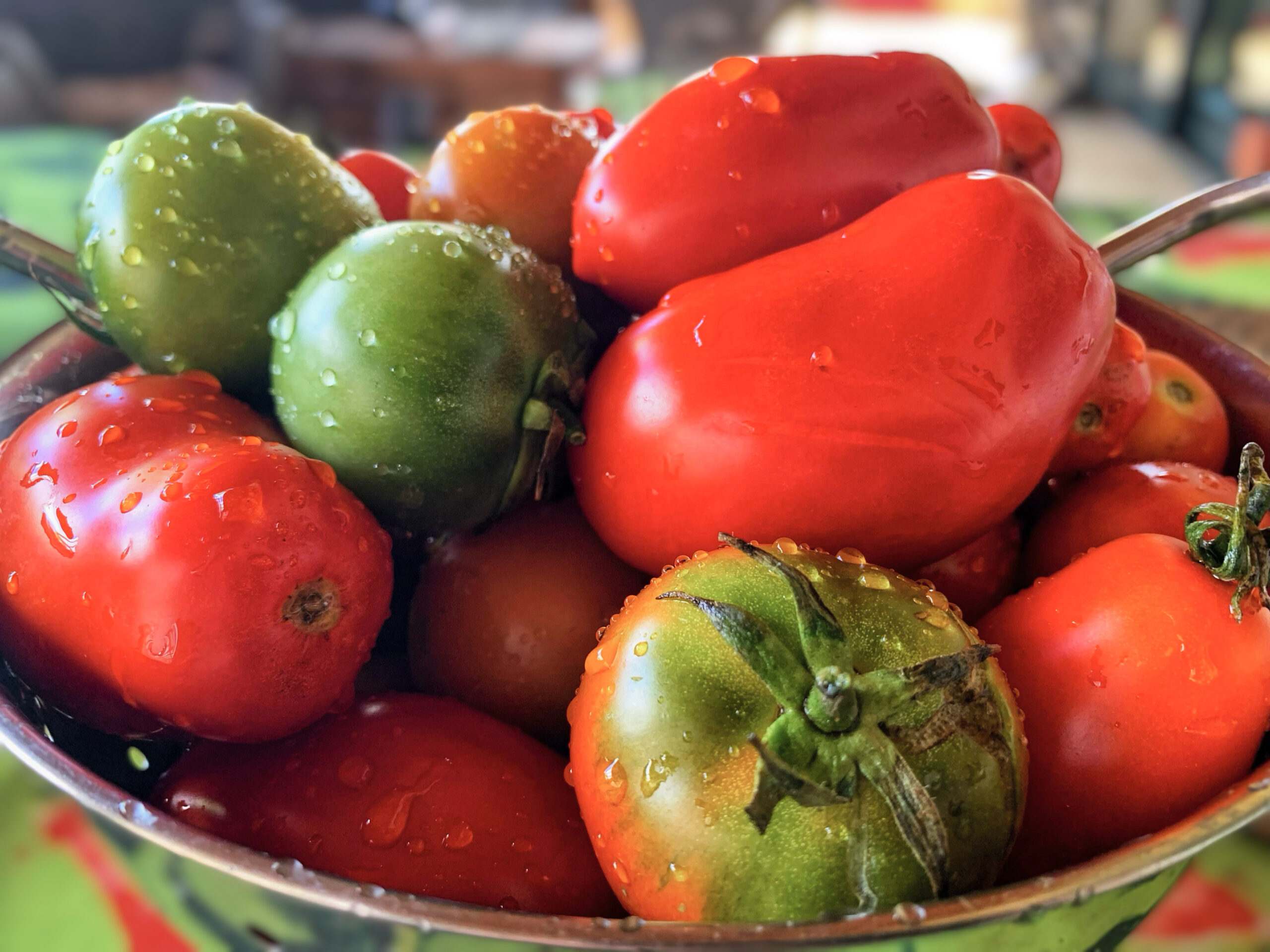Puglia is never more vibrant and alive than in the lazy heat of the summer sun that bakes the red earth of our olive grove. Summer is a season of slow nothingness when, defeated by the heat, we retreat indoors for la pausa and everything shuts down until aperitivo time.
Cicadas are the chorus of our summer evenings, when the smell of figs hangs heavy in the air
But in the mornings we wake up and smell the tomatoes. From mid-May through to September we celebrate pomodori in all their shapes and colours and tastes and sizes.
A Concentrated History
Tomatoes were being eaten in the Americas long before they were introduced to Europe. They came to the kingdom of Naples via Spain, as pomi d’oro (golden apples). It took nearly a century and a half before the first ever tomato sauce recipe appeared in Italy as ‘Salsa di Pomadoro, alla Spagnuola’ (Spanish tomato sauce).
Tomato Sauce, in the manner of Spain
Take half a dozen tomatoes, which must be ripe; put them on the coals to roast, and once they are seared, peel them with care and mince them finely with a Knife, and add Onions minced fine, at your discretion, Peparolo* also minced fine, a small amount of Serpollo, or Piperna**, and mixing everything together, season it with a little Salt, Garlic, & Vinegar, to make a Sauce that is delicious on boiled meats or other things.
Lo scalo alla Moderna, Antonio Latini published in Naples 1692
*considered to be a very hot pepper **both varieties of thyme
This was a watery broth. Before (and for some time after) pasta was usually dressed with a little butter and a lot of cheese. Even when the tomato sauce the cheese was still added to the pasta, but before the sauce was added!
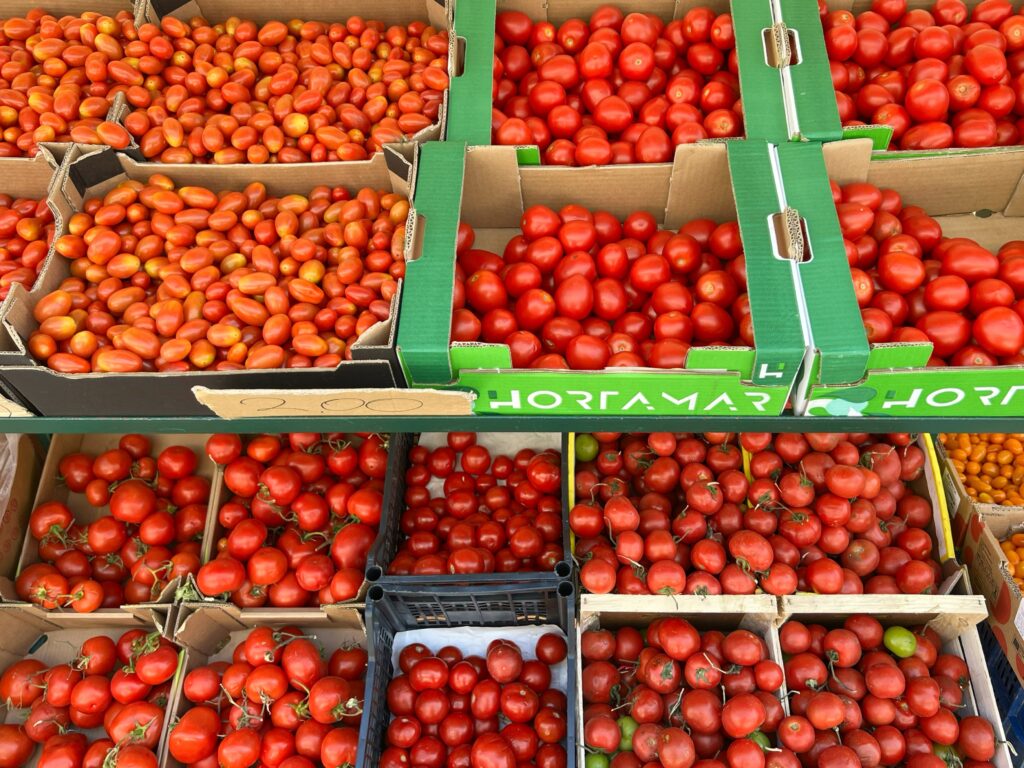
Jump to the Recipes
Basic Tomato Sugo
Tomato sugo (sauce) is the most commonly used base for our pasta dishes in the Puglia Kitchen. It can be made using fresh tomatoes, passata from a jar, or tinned Italian plum tomatoes. Whether simple and quick or made more complex with layered flavours, it should still taste like tomatoes!
Using Passata
No preparation is needed. Passata is made from fresh tomatoes. The tomatoes are cooked, crushed, then puréed and finally strained to remove any tomato pieces, skins and seeds.
Using Tinned Tomatoes:
If using tinned plum tomatoes, you can chop them roughly while still in the tin by repeatedly pulling a small knife through the tomatoes in a criss-cross pattern.
Using Fresh Tomatoes:
While peeling tomatoes isn’t essential when making sugo from fresh tomatoes, removing the juice and seeds usually is. This avoids a longer cooking time and stewed tomatoes!
The easiest way to remove the insides is to halve or quarter the tomatoes, depending on their size, and place them in a colander over the sink. Then, squeeze them by hand over the colander. Garden-fresh or morning bought market tomatoes are sturdy enough to withstand this without turning into mush. Once squeezed, rinse away the seeds under cold water. No need to be overly fastidious, just squeeze out what you can.
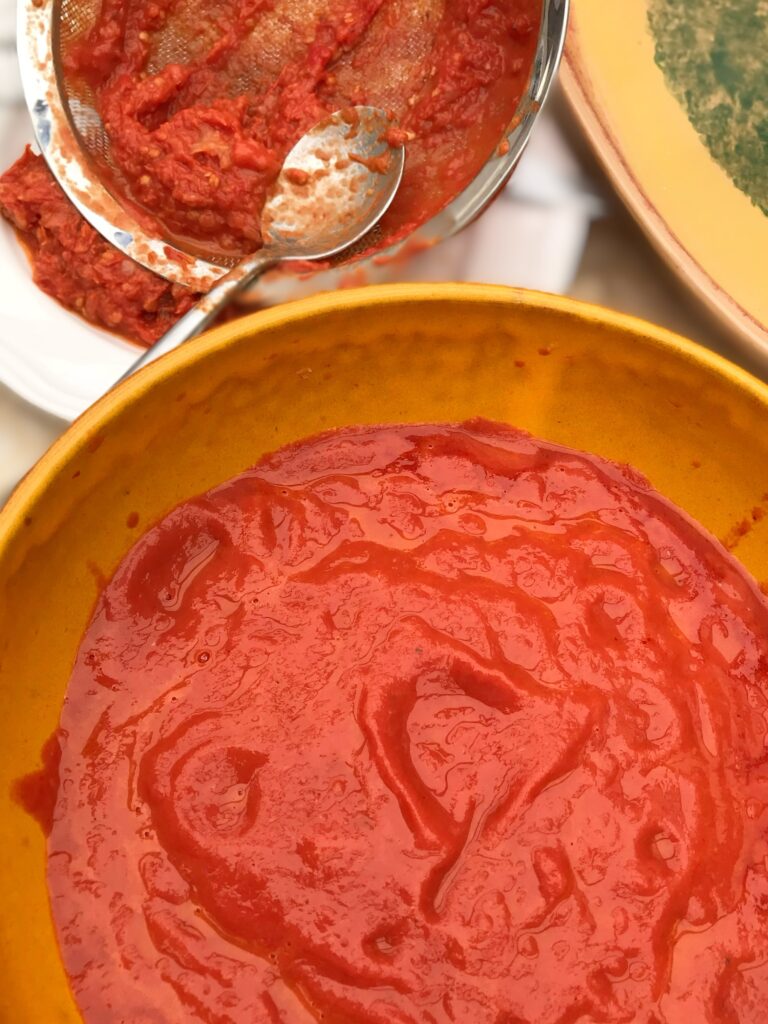
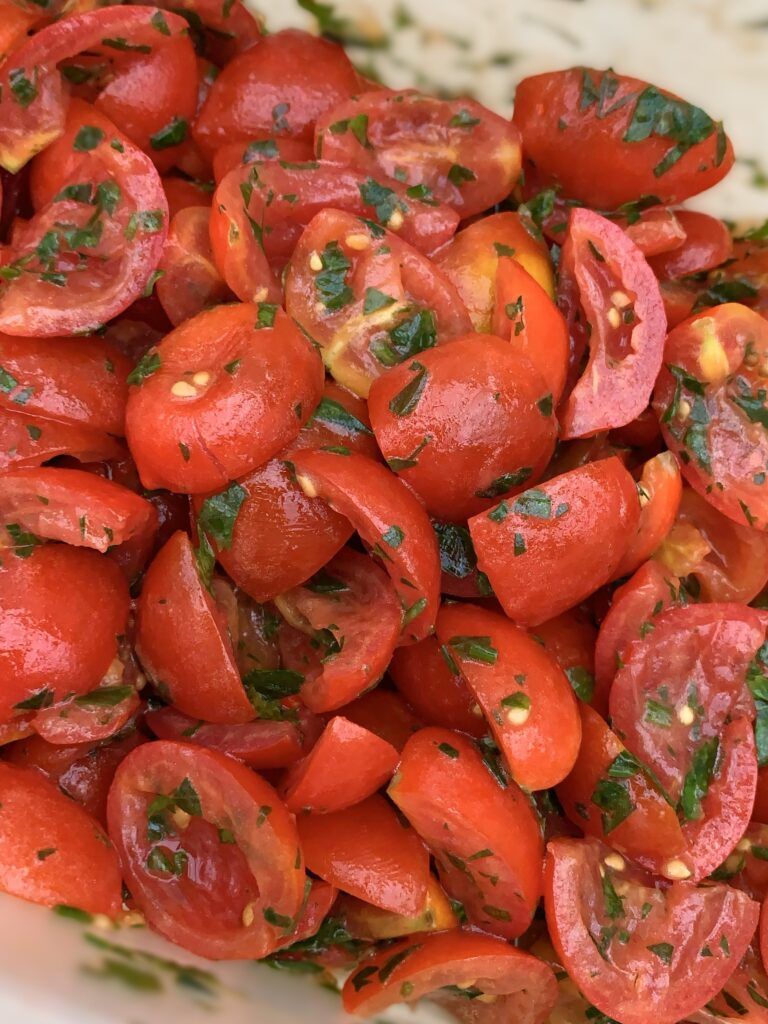
About Our Methods
We may suggest using a certain tomato and in some of the photos you might see that we have used another. That is because we cook seasonally based on whatever is available at the market that morning.
We might suggest using certain herbs for certain flavours, but in reality many are interchangeable, to taste. We often use bay because we have a glut of fresh bay leaves available, but also because we love its pungency and the depth it adds to a sauce. But you can use basil for a fresher, lighter scented sugo. Or oregano…
We might add to our sugo depending on what we are going to use it for. With fish or seafood, we will probably add lemon juice, chopped salted capers (in which case we need to ne mindful of how much salt we add elsewhere), and so on. Or we might add our some olives if the mood (and the need to use some up) takes us!
You can follow the recipes or simply use them as a guide.
Whichever pasta you use is up to you, but do be aware that the elegant engineering of almost infinite pasta shapes and sizes isn’t an Italian design aesthetic or creative flourish. It’s to ensure the perfect pairing of pasta and sauce.
Smooth, contoured ridges and thick ribbons of pasta better carry a ragù, while spaghetti, linguine and vermicelli are better served with wine or olive oil based sauces.
In the Puglia Kitchen orecchiette are often served up, though fusilli, trofie, strozzapreti, radiatori, caserecce and gemelli are also perfect with a tomato sauce.
Sugo Semplice | Simple Tomato Sauce
This is our simplest version of tomato sauce, made with passata or tinned tomatoes and the minimum of effort. We turn to this when we are very, very hungry and want a quick, satisfying lunch, or when having to slave over a hot stove in the summer heat is just too involved.
We use the same pan that we have already cooked the pasta in, which makes it a one pot pasta lunch (or dinner).
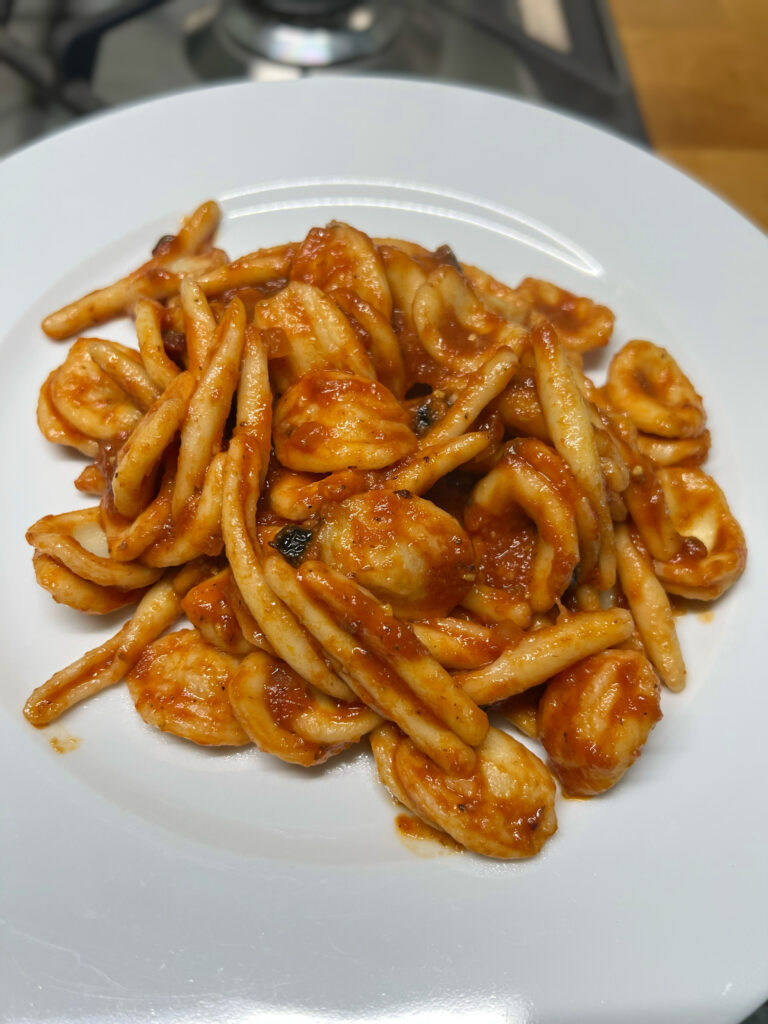
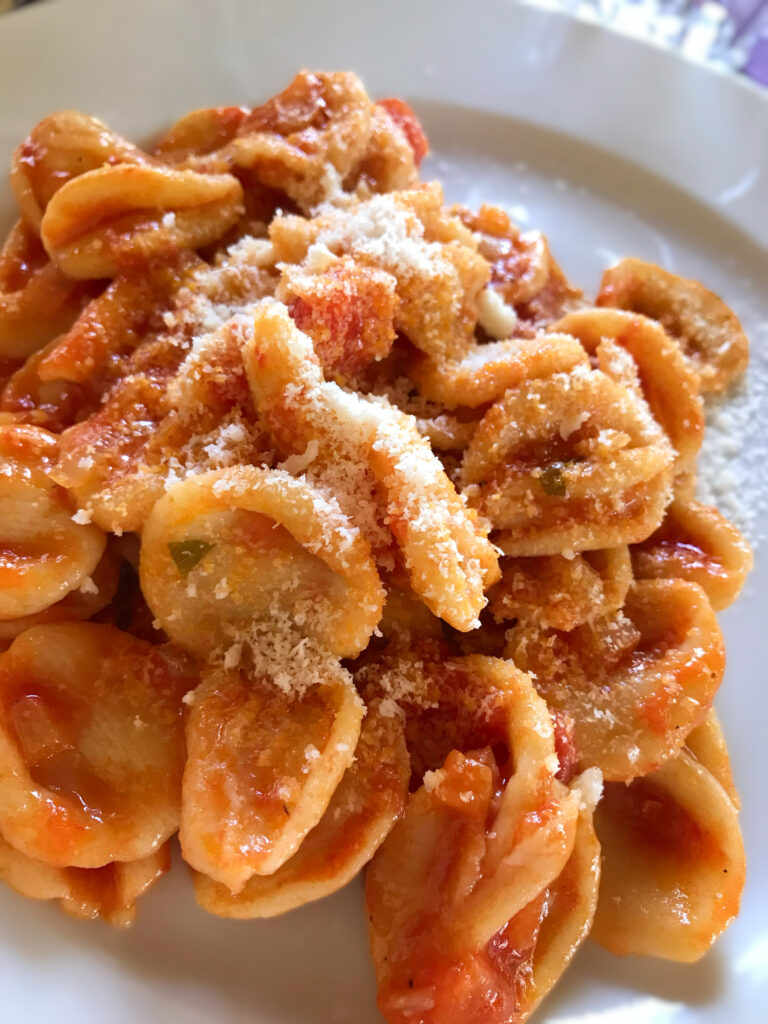
For this you will need:
- 350ml passata (or 400g tinned Italian plum tomatoes, chopped)
- 90ml extra virgin olive oil
- 2–6 anchovy fillets (optional)
- Salt and pepper to season
For 500g of pasta. We usually use orecchiette maritate, the default pasta of the Puglia Kitchen. It holds the sugo perfectly. However dried orecchiette maritate can take almost 20 minutes to cook. If we are hungrily impatient we use radiatori which cook in just over 5 minutes!
Cook the pasta according to the packet instructions, but turn off the heat a couple of minutes early. Reserve half a mug of the pasta liquor, then drain the pasta into a colander. Cover the colander with a lid and set aside. The pasta should be very definitely al dente, as it will continue to cook in the steam as it waits in the colander, and later sitting in the sugo.
In the empty pasta pan, heat the olive oil over medium heat. If using anchovies, add them now. Stir as they splutter and melt into the oil. Once they more or less disintegrate, add the passata (or chopped tomatoes).
Using the pasta pan helps contain splatters as the tomato sauce will bubble vigorously. Cover with a lid, turn the heat to low and stir occasionally so the sauce doesn’t catch on the bottom of the pan. After a couple of minutes, the sauce will change consistency, with the oil rising to the top and the colour turning from bright red to a deep orange. Season with salt and a generous grind of pepper, keeping in mind that the pasta liquor and anchovies will add saltiness.
Stir the sauce well to combine with the oil, then turn off the heat. Add the cooked pasta to the sauce and gently stir. If we have some at hand we throw in some torn basil leaves. Cover the pan and allow the pasta to sit in the sauce for a minute or two. As it does it will continue to cook and absorb the sauce. Before serving, adjust the consistency of the sauce or slacken the pasta by adding some reserved pasta liquor if needed.
Serve immediately, and sprinkle with Parmesan to taste (quanto basta). Traditionally orecchiette isn’t served with Parmesan or any other hard cheese. Grated cacioricotta (a harder salted cheese from Puglia) is used. But we won’t tell if you don’t!
Pasta to Sauce Ratio:
The pasta should not be swimming in the sauce. In the Puglia Kitchen, we prefer the sauce to cling to the pasta rather than drown it. This recipe is designed for 500g of dried or fresh pasta. Always reserve some pasta liquor to adjust the sauce at the end.
Sugo Semplice v1.5 | Simple Tomato Sauce v1.5
When we are feeling a little more energetic and able to spend time over the stove in the full heat of Puglia’s summer, this is our simple sugo made with just a little more effort and taking just a little more time.
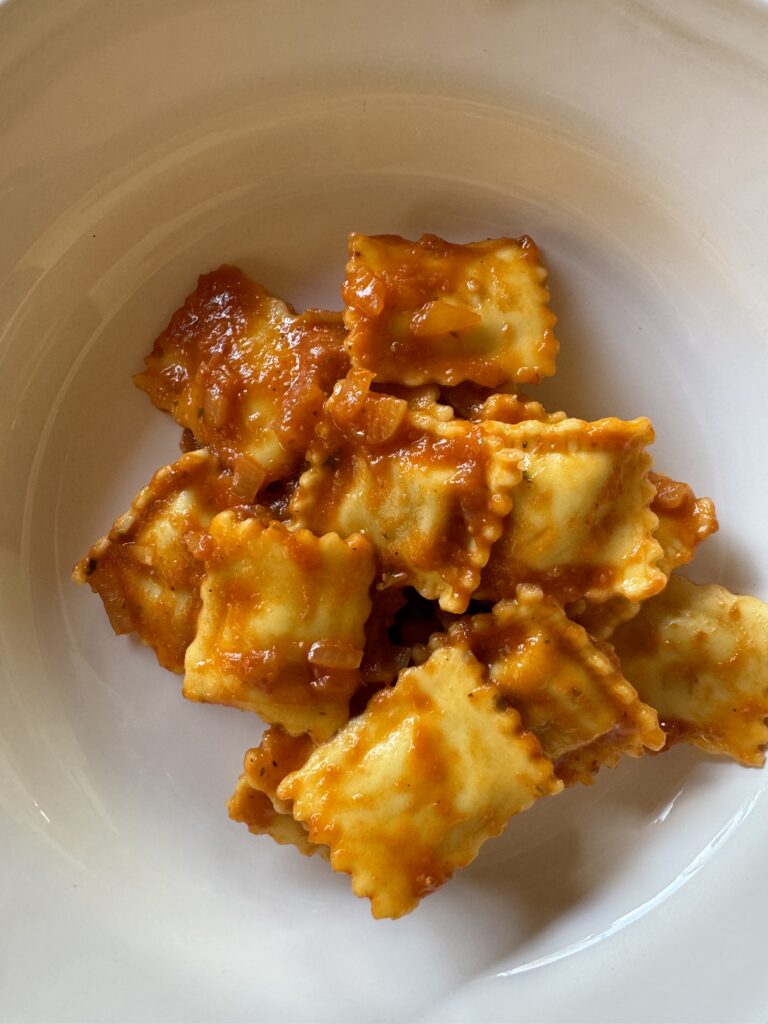
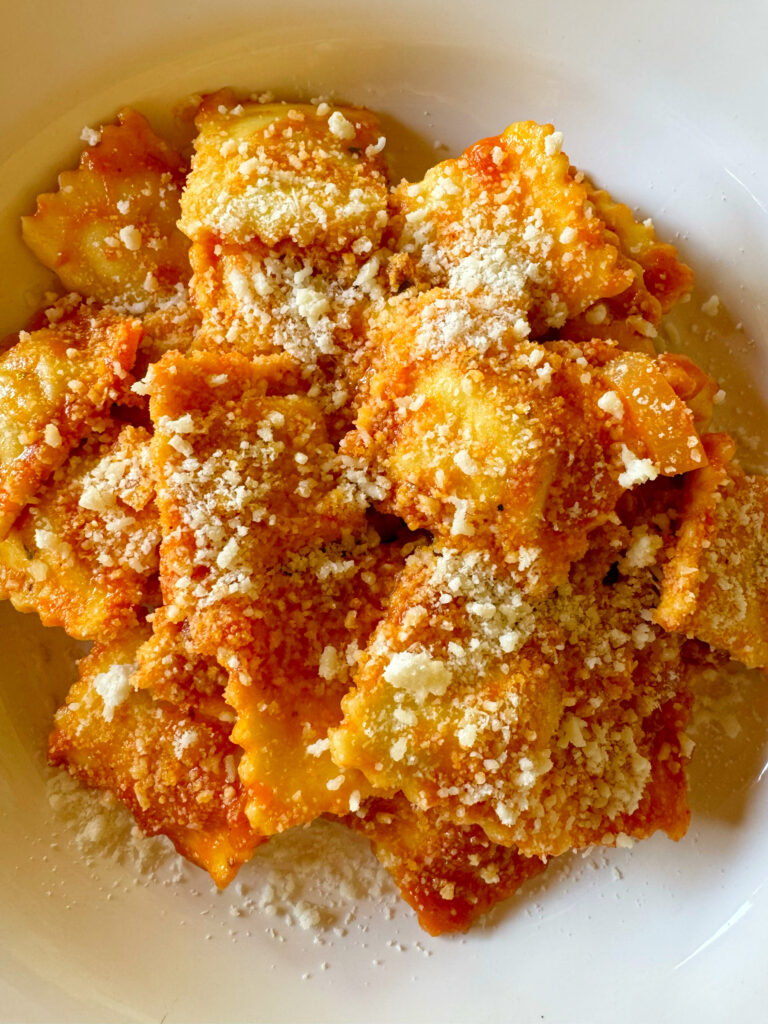
For this you will need:
- 350ml passata (or 400g tinned Italian plum tomatoes, chopped)
- 90ml extra virgin olive oil
- 1 medium-sized onion
- 2–6 anchovy fillets (optional)
- Salt and pepper to season
For 500g of pasta. Great with spaghetti, but this is a sauce you can use with almost any pasta, including stuffed pasta. Here we used it for fresh ravioli.
Start with the sugo.
Peel and finely chop the onion. In a heavy-based saucepan or large, deep frying pan (big enough to hold the cooked pasta), heat the olive oil over a medium heat. Add the anchovy fillets if using, and stir until they start to melt.
Add the chopped onion to the pan and fry gently until it becomes soft and translucent.
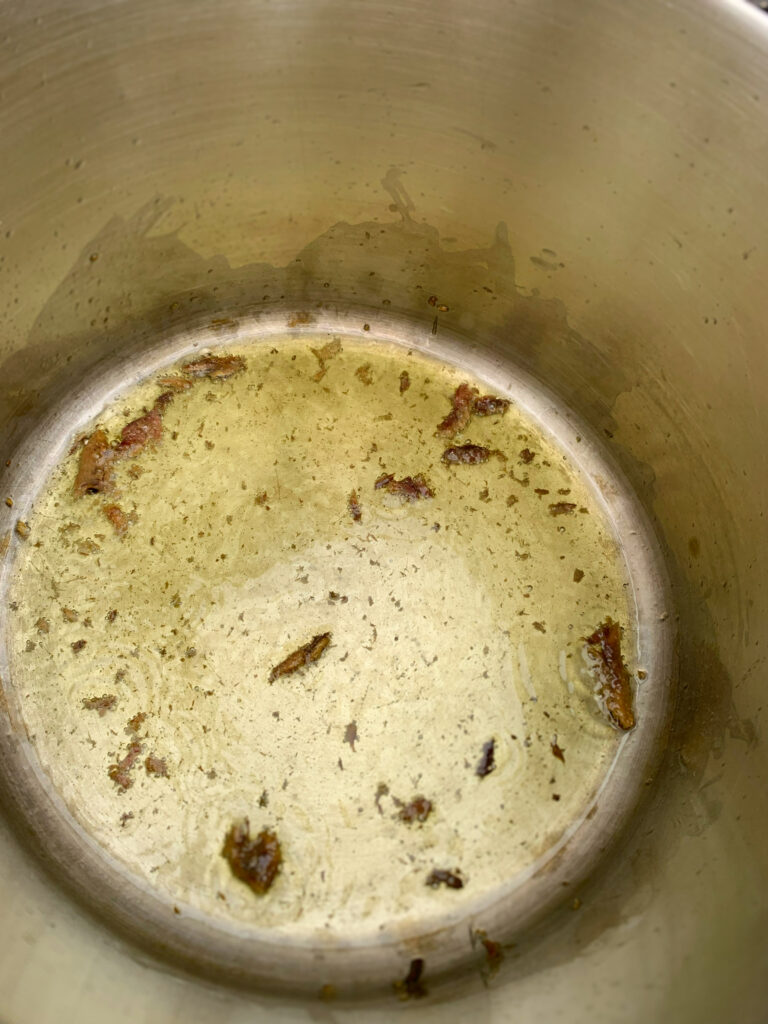
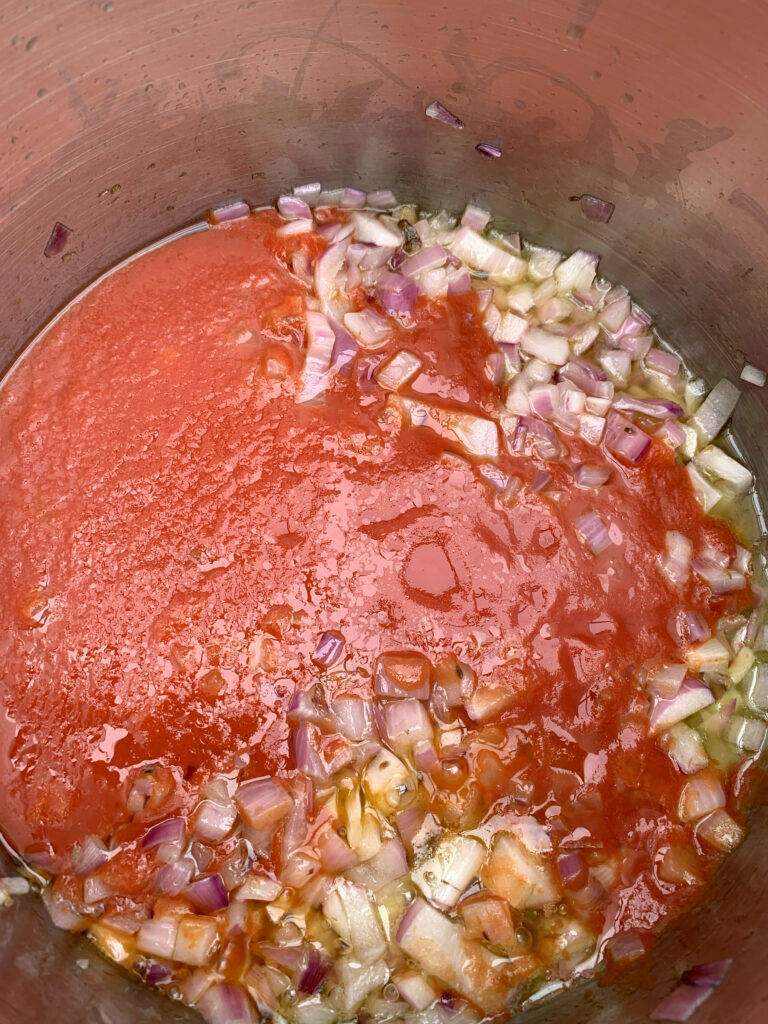
Pour in the passata or tinned tomatoes. If using tinned tomatoes, add a pinch of salt now (if using passata, season with salt and pepper once the sauce is done). Increase the heat until the tomatoes are near boiling point, then reduce to a low simmer. Cook the sugo for 30–40 minutes, stirring occasionally to prevent sticking. The sauce will thicken, and its colour will change to a burnt orange.
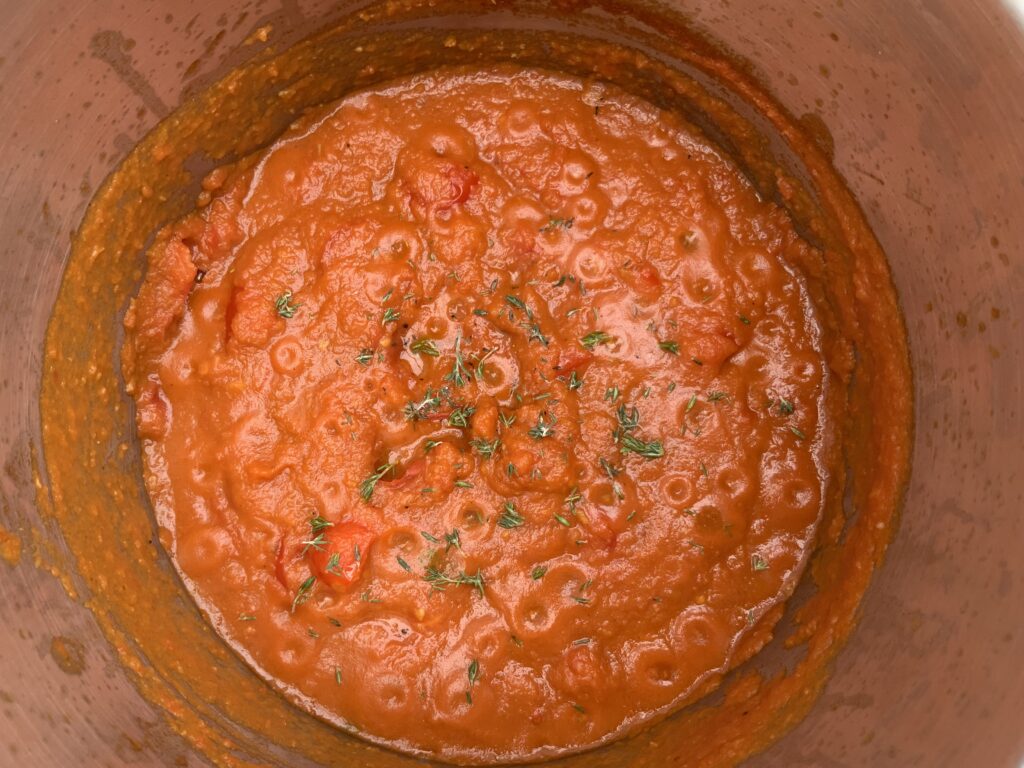
Meanwhile, bring a large pan of water to a rolling boil. Add a generous amount of salt (as a rule of thumb we use 1 litre of water per 100g of dried pasta, with 10g of coarse salt or 5g of table salt) and cook the pasta until al dente. Reserve half a mug of the pasta liquor, then drain the pasta.
Add the drained pasta to the sauce (now is the time to add some torn basil if you have some) and cover the pan with a tight fitting lid. Hold the lid in place using a clean dish towel pulled over the lid and wrapped around the pan handles. Gently flick the pan (as if flipping pancakes) a few times to coat the pasta with the sugo. Let the pasta rest in the sauce for just over a minute.
Lift the lid and check the texture. The sauce should be silky. If it seems too dry or the pasta needs to be slackened, add some of the reserved pasta liquor and stir gently. Serve immediately, topping with Parmesan or other fresh grated hard cheese of choice quanto basta.
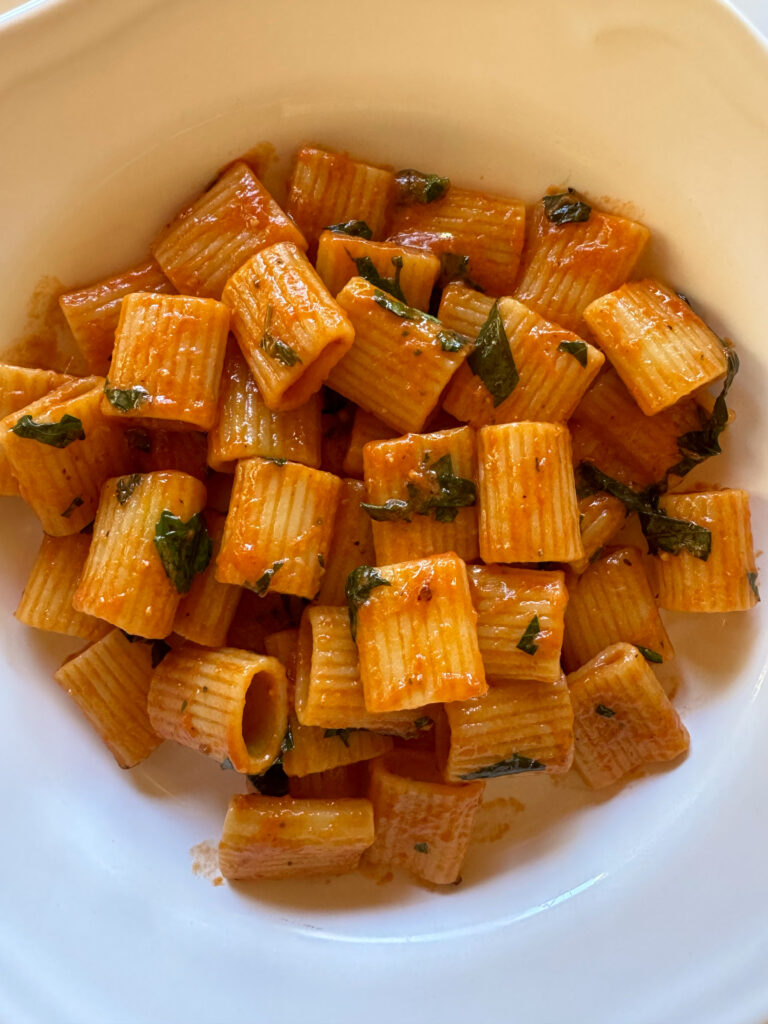
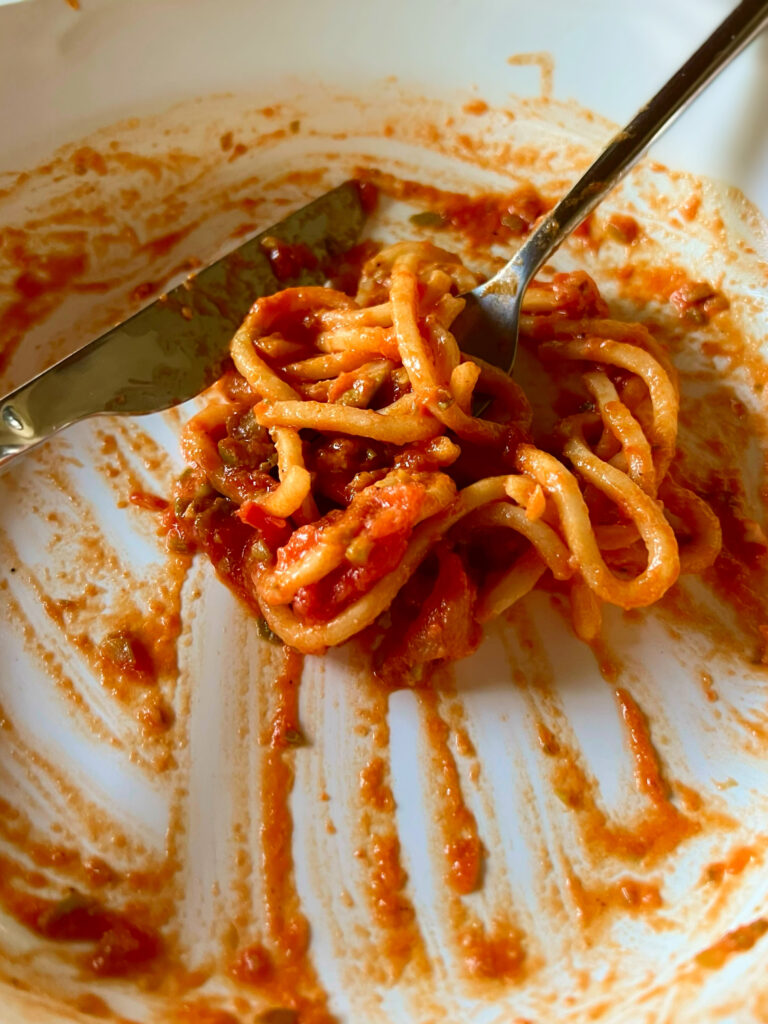
About the Onions:
We often use red onions in this version and other variations of our sugo, specifically the Acquaviva or Tropea varieties. The Acquaviva red onion, taking its name from Acquaviva delle Fonti where it is grown, is native to Puglia. It has a large, flat shape with purplish skin, pinky white flesh and a sweet, delicate flavour. It is harvested in July and August.
Tropea red onions are oval-shaped with a purplish hue, known for their sweetness. Locals even say a good Tropea onion is sweet enough to eat like an apple—though we haven’t tried it!
Summer Tomato Sugo
This is our basic tomato sauce made with fresh tomatoes, whether from the garden or bought that morning from one of the many market stalls around town. We use whichever tomatoes are available, such as Fiaschetto, Roma, Datterini, San Marzano, or Ciliegino.
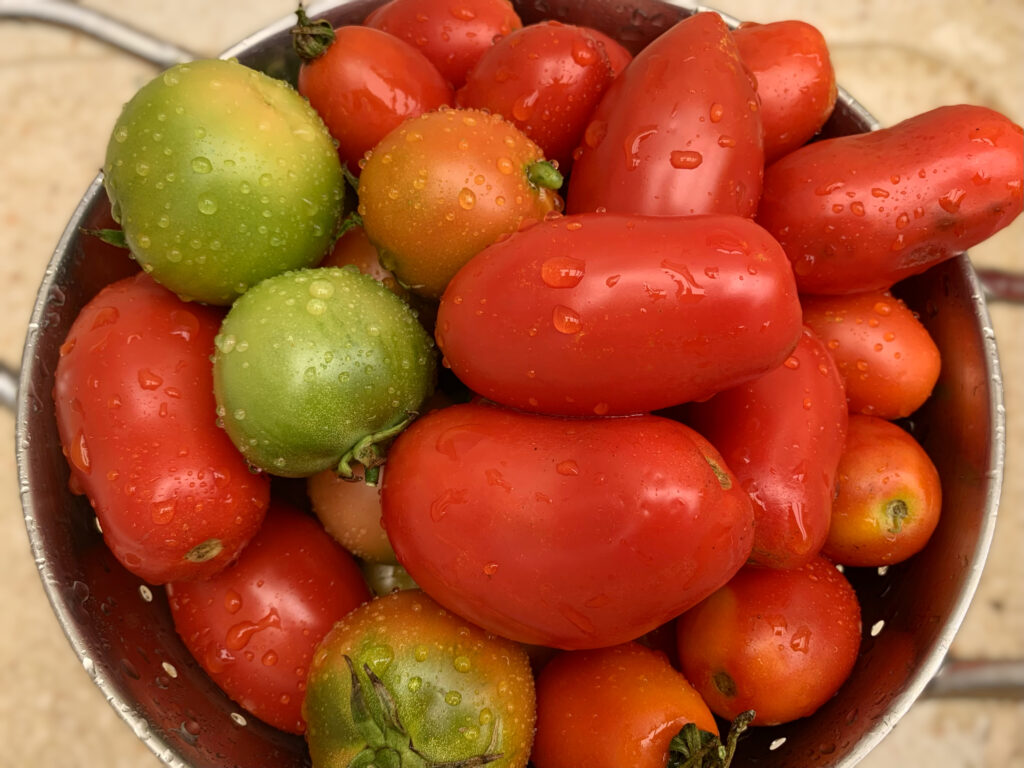
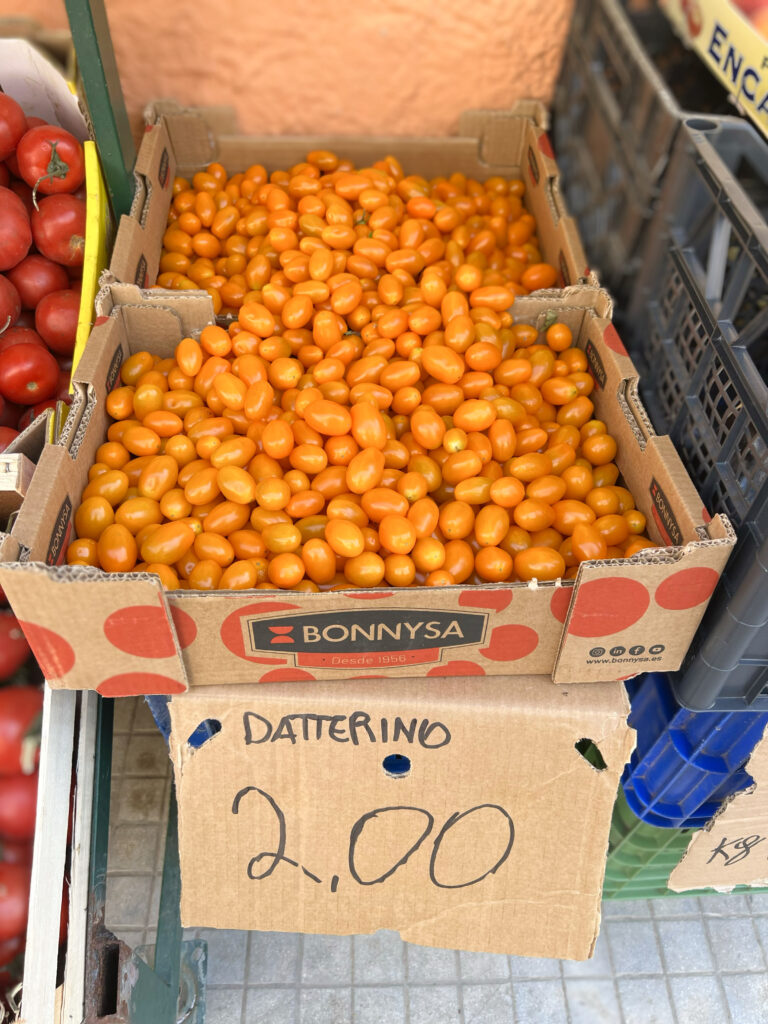
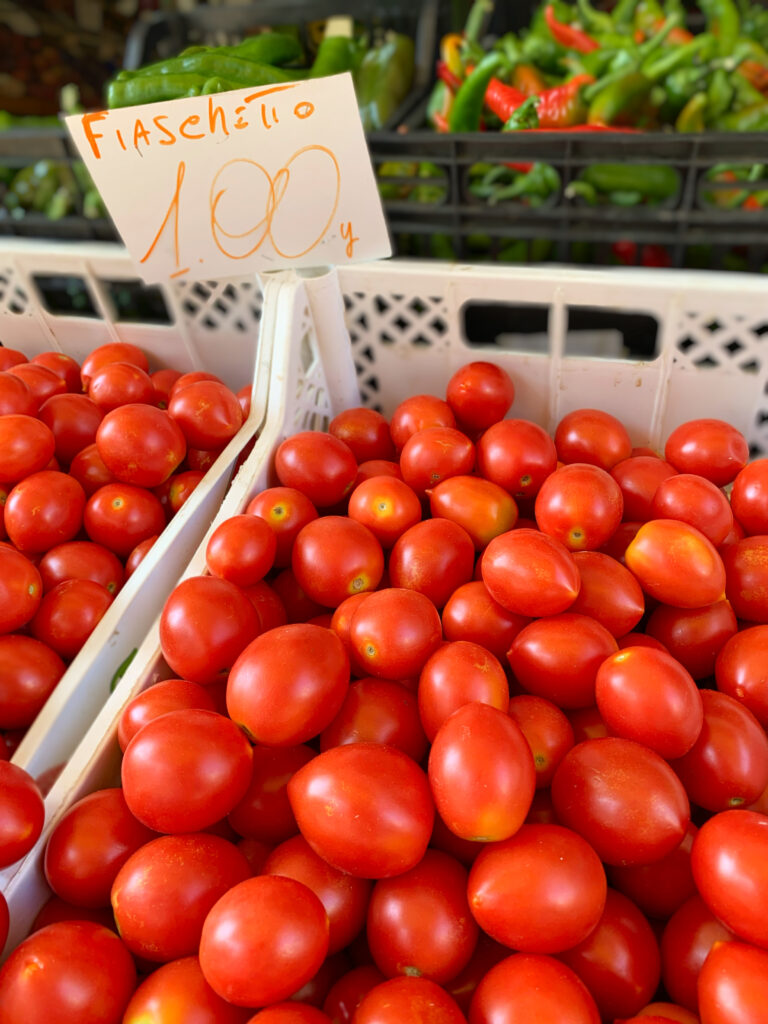
While peeling tomatoes isn’t essential when making sugo from fresh tomatoes, removing some of the juice and seeds is. This avoids a longer cooking time and stewed tomatoes!
Preparing Fresh Tomatoes:
The easiest way to remove the insides is to halve or quarter the tomatoes, depending on their size, and place them in a colander over the sink. Then, squeeze them by hand over the colander. Garden-fresh or morning bought market tomatoes are sturdy enough to withstand this without turning into mush. Once squeezed, rinse away the seeds under cold water. No need to be overly fastidious, just squeeze out what you can.
Though we typically make it as needed, you can double the recipe and store or freeze the leftover sugo for later.
For this you will need:
- 500g tomatoes
- 90ml extra virgin olive oil
- 1 medium-sized onion
- 2–6 anchovy fillets (optional)
- 2 bay leaves
- ½ tsp salt for the sauce
- Salt and pepper to season
For 500g of pasta.
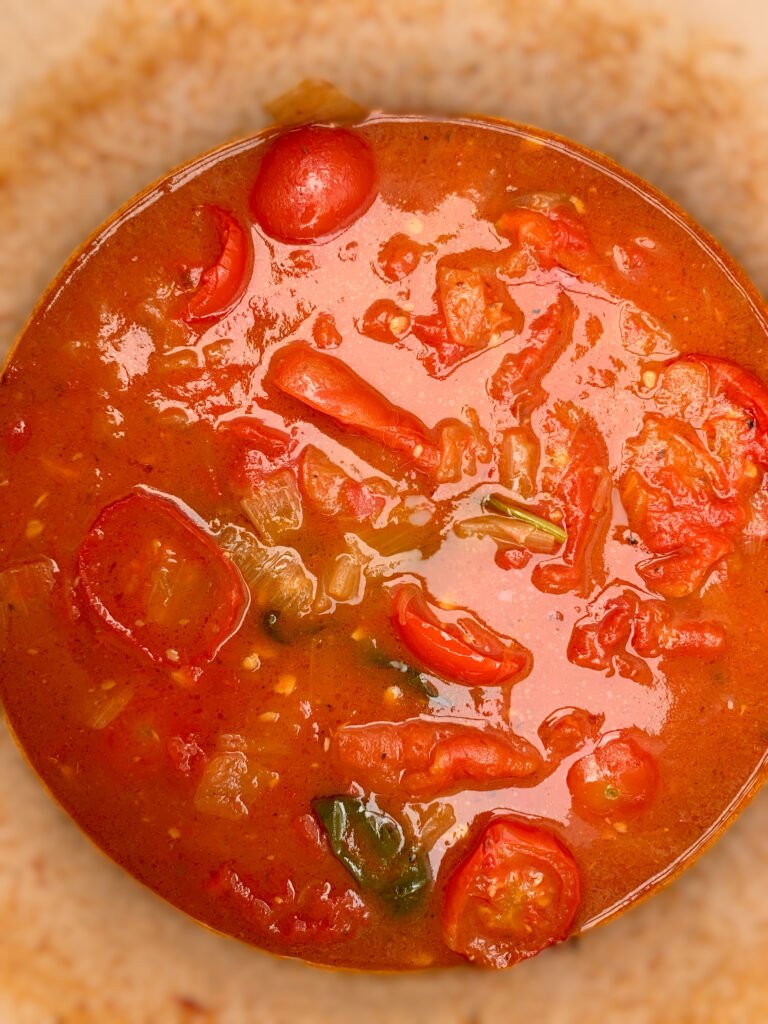
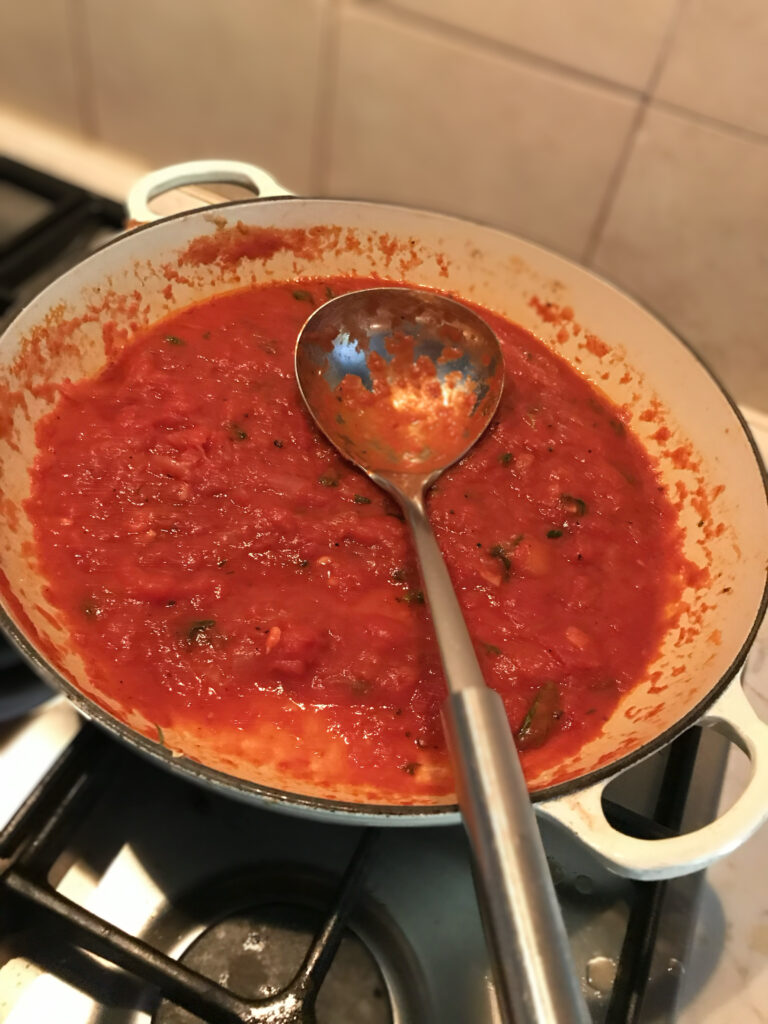
Cut the tomatoes in half or quarters, depending on their size, and squeeze out some of the seeds and juice from around a third of them. The rest you can leave intact.
In a frying pan, heat the olive oil over medium-low heat. Add the onion and fry gently until soft and translucent.
Add the tomatoes to the pan along with ½ teaspoon of salt, a grind of black pepper, and the bay leaves. Increase the heat and cook the tomatoes down at a gentle simmer, stirring occasionally to prevent sticking. This will take around 30–40 minutes. As the tomatoes cook, squash them from time to time to help the sauce become smoother.
Serve the sauce with spaghetti or your preferred pasta. Add reserved pasta liquor as needed to adjust the consistency of the sauce if it feels stiff.
Tomato and Bay Leaf Sugo
Bay leaf adds incredible depth to many dishes in the Puglia Kitchen. We use fresh leaves picked from the bay laurel bushes in our olive grove. Forget the almost flavourless dried bay from supermarket bought packets – fresh bay leaves pack a big aromatic punch. In this recipe, we want the bay to power through. To release their full flavour we lightly crush the leaves closing them in our fist, before adding them to the sauce.
This sauce also includes cinnamon, a nod to the North African influences in Puglia’s cuisine. A pinch of cinnamon brings a surprising warmth that complements the bright acidity of fresh tomatoes.
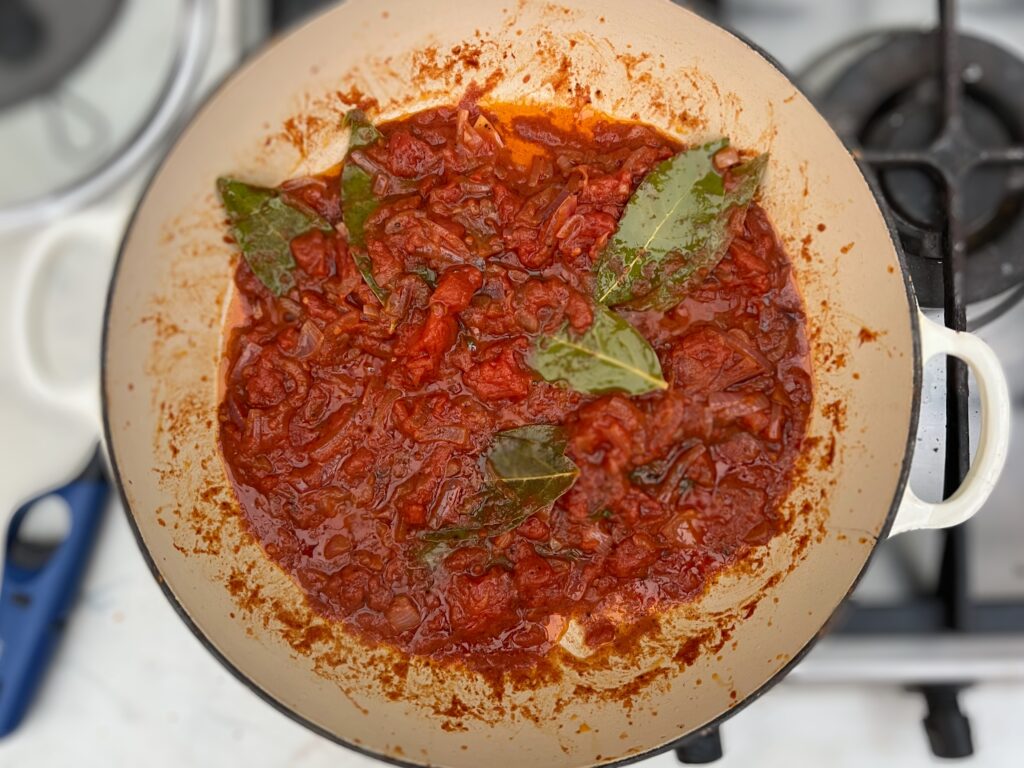
For this you will need:
- 500g tomatoes
- 70ml extra virgin olive oil
- 20g butter
- 1 medium-sized onion
- 6–12 bay leaves
- ½ tsp salt
- ½ tsp cinnamon
- Salt and pepper to taste
For 500g of pasta. For max satisfaction we prefer to use spaghetti with this sauce. The slick of the spaghetti strands through the sugo is worth it. Alternatively we toss our polpette (meatballs) in this sauce taking them from the sublime… to ridiculously delicious!
Cut the tomatoes in half or quarters, depending on their size, and squeeze out the seeds and juice. Discard the seeds and juice. This should be a less wet sauce, and on this occasion we prefer to squeeze out as much as we can.
In a frying pan, heat the olive oil and butter over medium-low heat. Add the onion and fry gently until soft and translucent.
Add the tomatoes, lightly crushed bay leaves, ½ teaspoon of salt, a grind of black pepper, and the cinnamon. Stir to combine.
Increase the heat to medium and let the tomatoes cook down at a gentle simmer, stirring occasionally to prevent sticking. This will take about 15 – 20 minutes. As the tomatoes soften, press them gently with the back of a wooden spoon to help the sauce become smoother.
Meanwhile, cook the spaghetti in a separate pan according to the instructions. Reserve half a mug of the pasta liquor, then drain the pasta when al dente.
Add the drained pasta to the sauce, cover the pan, and flick it gently to coat the pasta with the sugo. Let the pasta rest in the sauce for a couple of minutes.
Remove the lid and add the reserved pasta liquor if the sauce needs loosening – but keep in mind that this should be a more robust sauce. Remove the bay leaves before serving, using some as a garnish.
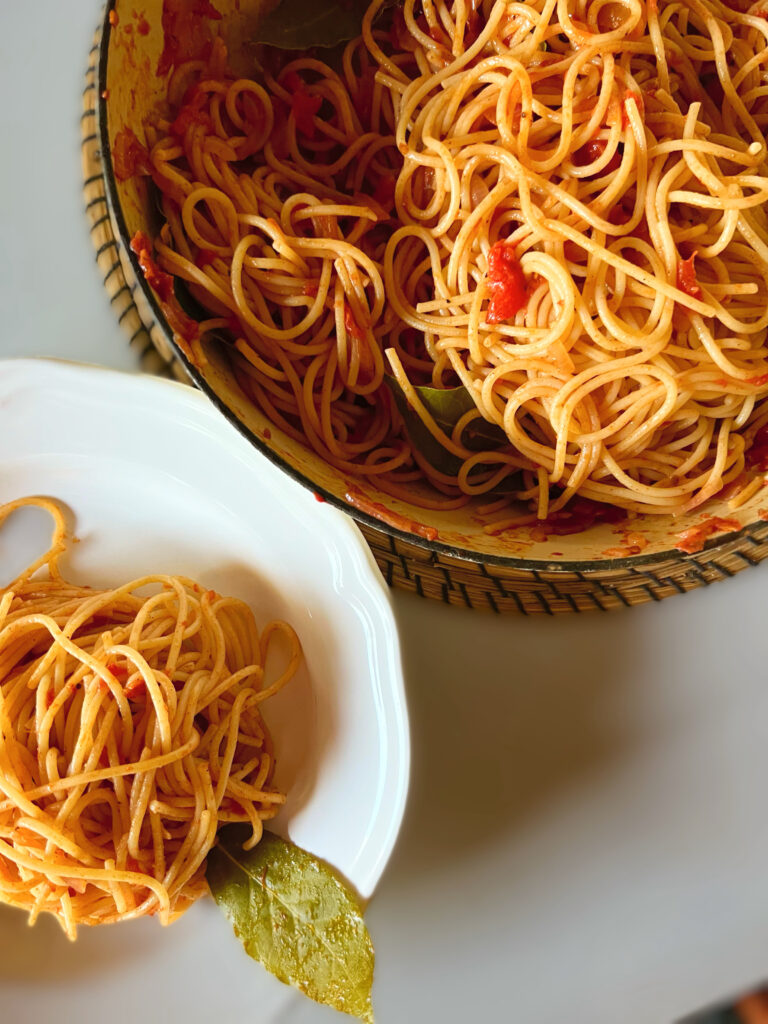
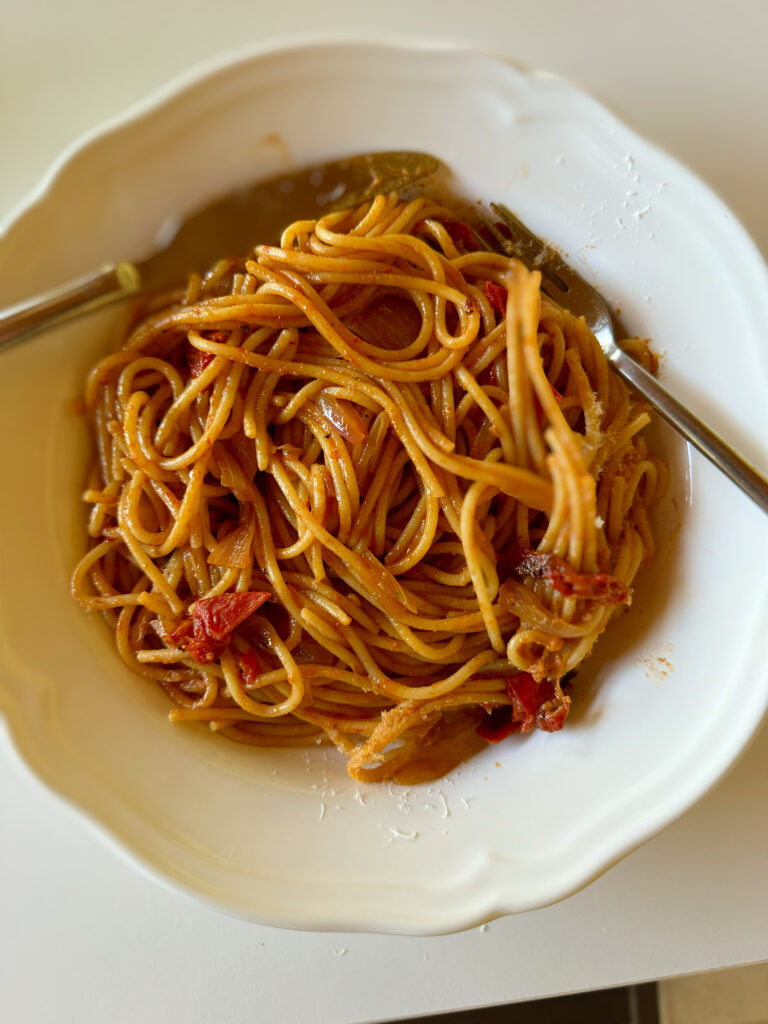
Pomodori Scattarisciati | Popping Tomatoes
Cherry tomatoes are perfect for this dish. No need to worry about chopping or deseeding the tomatoes. Use them whole. The tomatoes will burst and collapse as they cook, releasing their juice which emulsifies the oil to make a silky sauce that clings perfectly to cooked pasta, studded with jewels of popped, ruby red tomatoes.
This dish is sometimes served as a side dish without pasta. Often with bombette and other meat treats from the Braceria, or it can be be dolloped onto thick slices of pan-toasted bread and eaten bruschetta style.
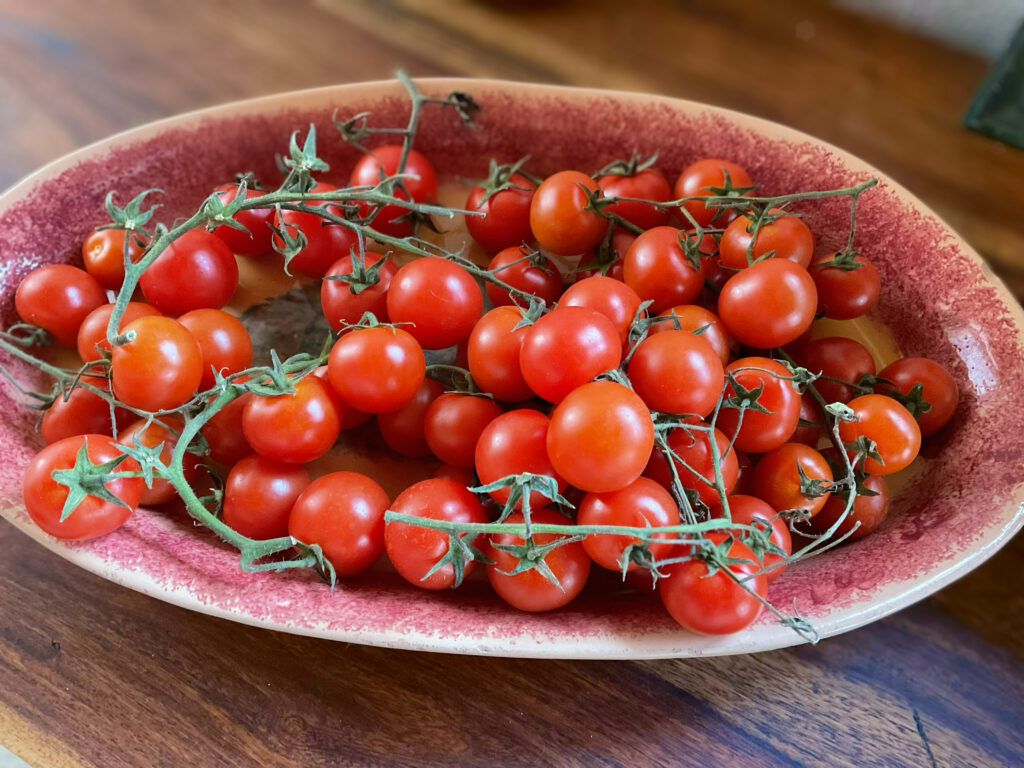
For this you will need:
- 1kg cherry tomatoes (or other small tomatoes, or a mix)
- 200ml extra virgin olive oil
- 3 cloves garlic, peeled and slightly crushed (with the back of a knife, though the cloves should remain intact)
- 1 pinch chilli flakes (or 1 dried or deseeded red chilli, chopped)
- 2 bay leaves
- A pinch of salt, plus salt and black pepper to taste
For 500g of pasta. Spaghetti is the traditional pasta and linguine works equally well. We like to use troccoli, a type of fresh pasta widely used in the Foggia area, reminding us of visits to Vieste, on Puglia’s Gargano peninsula. Similar to spaghetti the troccoli has a rougher square shape that catches more of the sauce. It is made using a special grooved rolling pin, called the “troccolaturo di bronzo” (from the Latin turculum), from which the pasta gets its name.
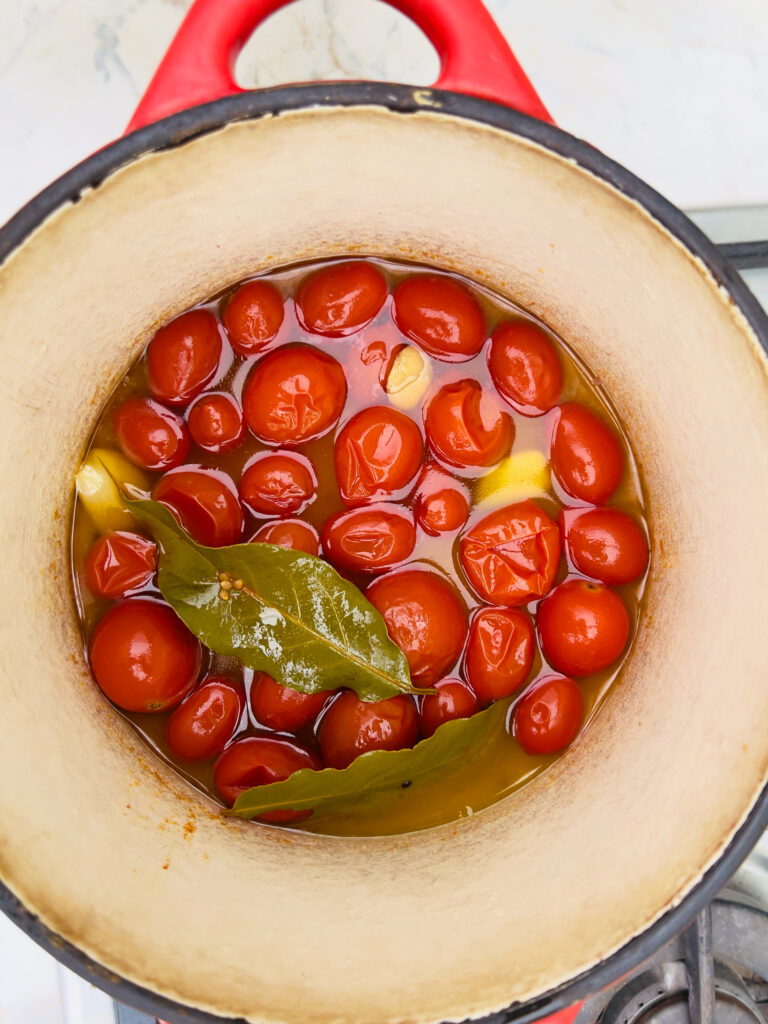
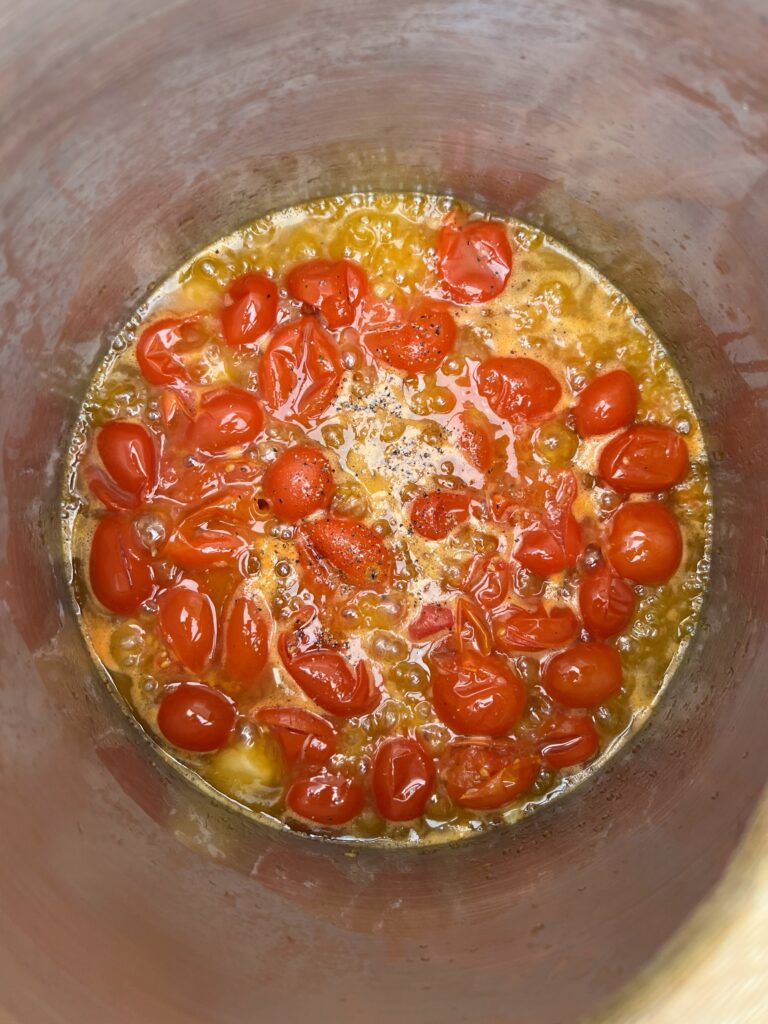
Put the crushed garlic and chilli in a heavy-bottomed cold pan (one that has a tight fitting lid). Add the olive oil and heat gently to allow the garlic and chilli to infuse and sizzle gently, taking care the garlic doesn’t brown.
After a couple of minutes add the tomatoes to the pan whole, and season with a generous pinch of salt. Add the bay leaves and stir so the tomatoes glisten and gleam in the oil. Put the lid on the pan, turn the heat up high and cook for 10 minutes, shaking the pan from time to time in a circular motion so the tomatoes roll around inside. After a few minutes, the tomatoes will begin to wrinkle, split, and collapse.
During the cooking, remove the lid and use the back of a fork to press the split tomatoes, dragging them around the pan. Cover the pan again and cook for a few more minutes. Repeat the process—dragging, pressing, and cooking—until the oil emulsifies and turns opaque and slick.
Season well with salt and pepper. The tomato sugo is now ready for the pasta. Add the cooked pasta to the pan, cover, and flip the pan to coat the pasta in the sauce. Let it rest for a minute, then add reserved pasta water as needed to adjust the consistency. Serve immediately.
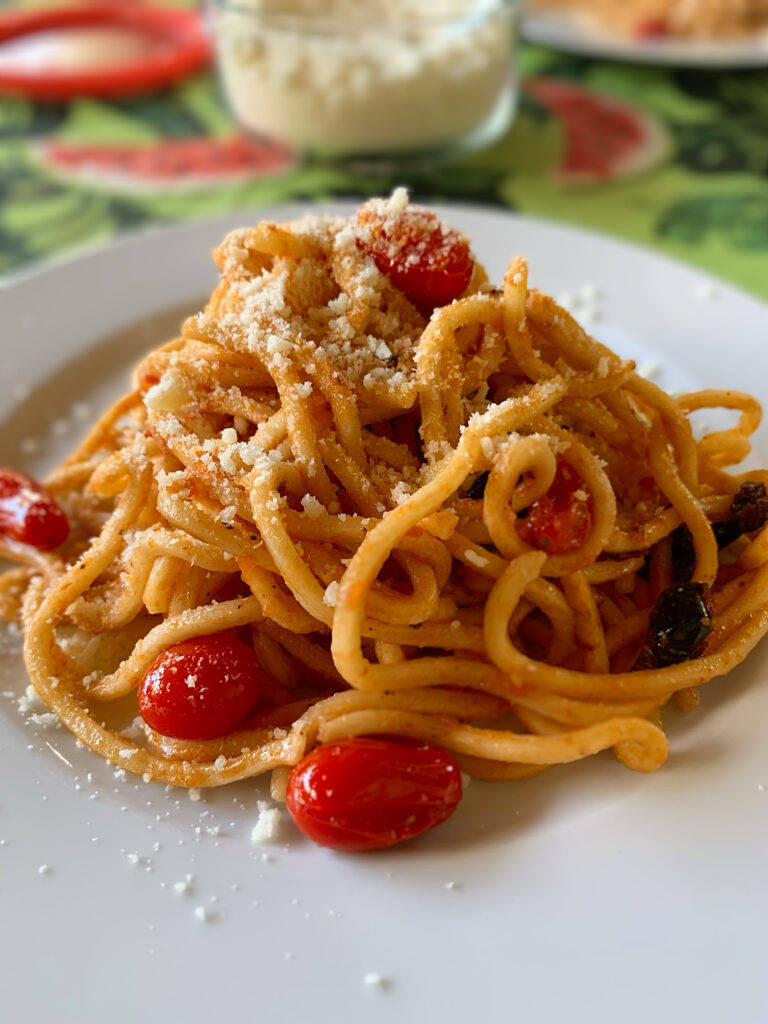
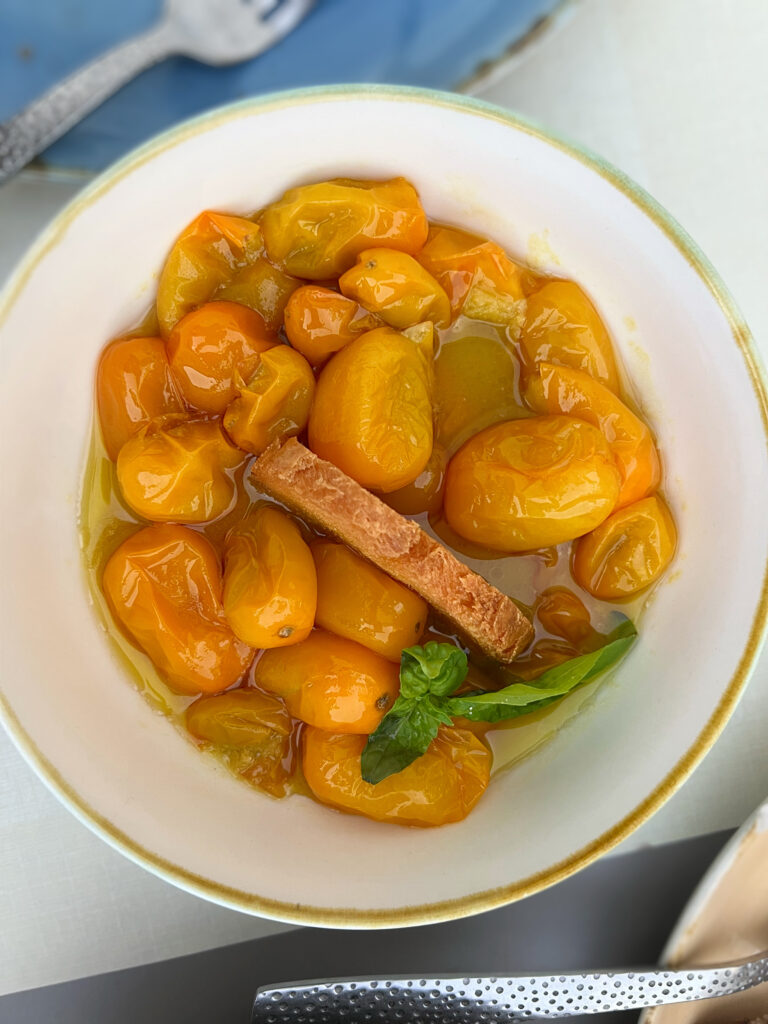
Sauces To Preserve and Store
A surfeit of tomatoes towards the end of summer means it’s time to start preserving!
These are some of the ways we preserve our tomatoes so that we can simply add them to cooked pasta over the winter months when the Puglia Kitchen garden has no tomatoes to harvest.
Store Cupboard Tomato Sugo
There’s always an exception to quick sauces. For our preserved tomato sauce that keeps us going through the winter, we cook it long and slow.
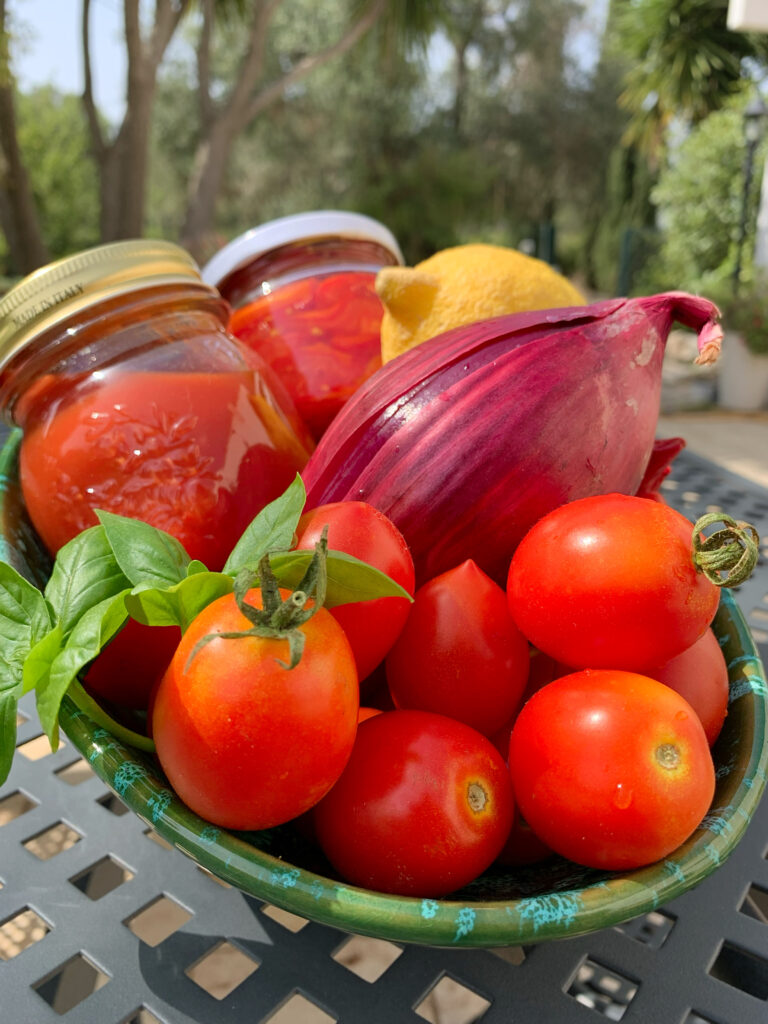
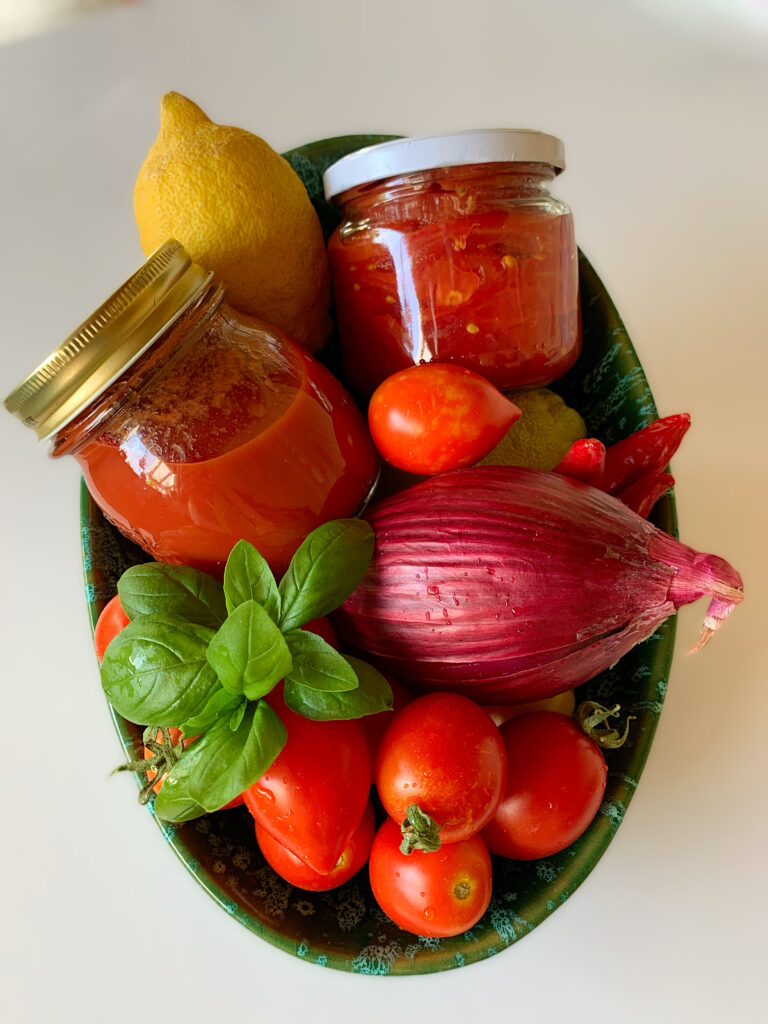
For this you will need:
- 4kg fresh tomatoes, mixed and roughly chopped
- 3 medium onions, finely sliced
- 120g extra virgin olive oil
- Fresh basil leaves, a handful, torn
- 40g caster sugar
- Zest of 2 lemons
- 1 tsp salt
In a large saucepan, heat the olive oil over medium heat. Add the sliced onions and cook for about 15 minutes, until soft and translucent. Be careful not to let the onions burn or char at the edges.
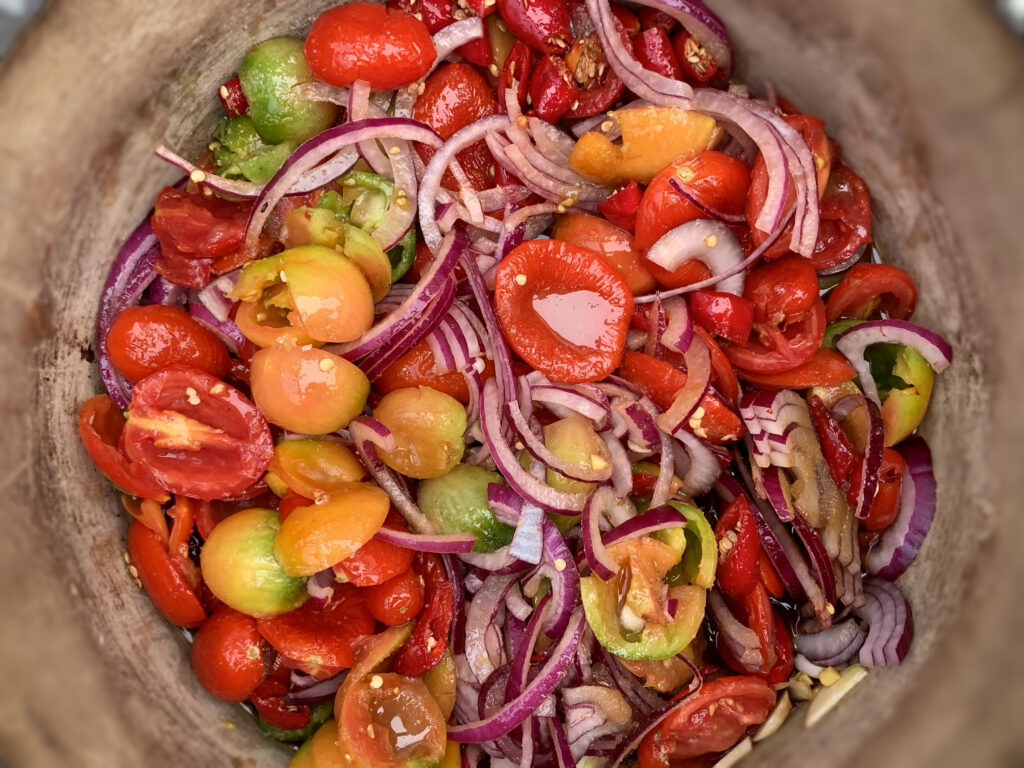
Add the chopped tomatoes to the pan and sprinkle the salt evenly over them. The salt helps draw moisture out of the tomatoes, allowing it to evaporate during cooking. Increase the heat and cook for 5 minutes, letting the tomatoes start to collapse into the sauce.
Reduce the heat to very low, then add the torn basil leaves and the caster sugar. Simmer gently, uncovered, for 3–4 hours, stirring occasionally to prevent sticking. As the sauce cooks, press the tomatoes with the back of a wooden spoon to help them break down and gradually smooth the sauce.
Once the sauce has reduced by half, turn off the heat and stir in the lemon zest. Allow the sauce to cool.
Once cooled, transfer the sauce to a food processor and blend to a semi-smooth consistency—somewhere between a passata and a purée. Don’t worry if it becomes a bit too smooth; it won’t affect the taste, only the texture.
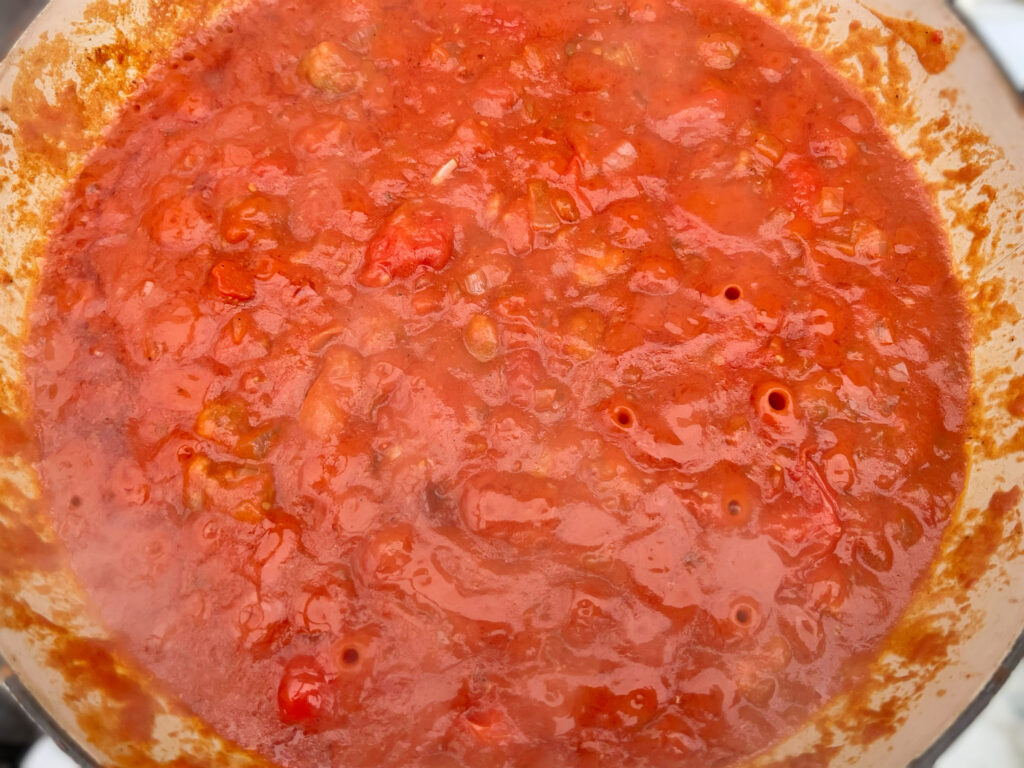
Transfer the sauce to sterilised jars and seal them tightly. Store in a cool, dry place for later use.
Serving the Sauce:
Use the store cupboard sugo just like sugo semplice. After cooking the pasta, drain it, then heat the sauce in the empty pasta pan with a bit of olive oil. You can add anchovies if desired, though it’s not necessary. Heat the sauce, then add the pasta and let it rest with the lid on. Add reserved pasta water if needed to adjust the sauce’s consistency.
Tomato Confit
We use this recipe as a guide, often adapting it to our taste. For example, we add less sugar, use dried thyme (rolling the sprigs between our palms to shed the leaves), and adjust the amount of oil based on the tomatoes. You can experiment too, adding fresh sage, oregano, or even substituting some tomatoes with red peppers.
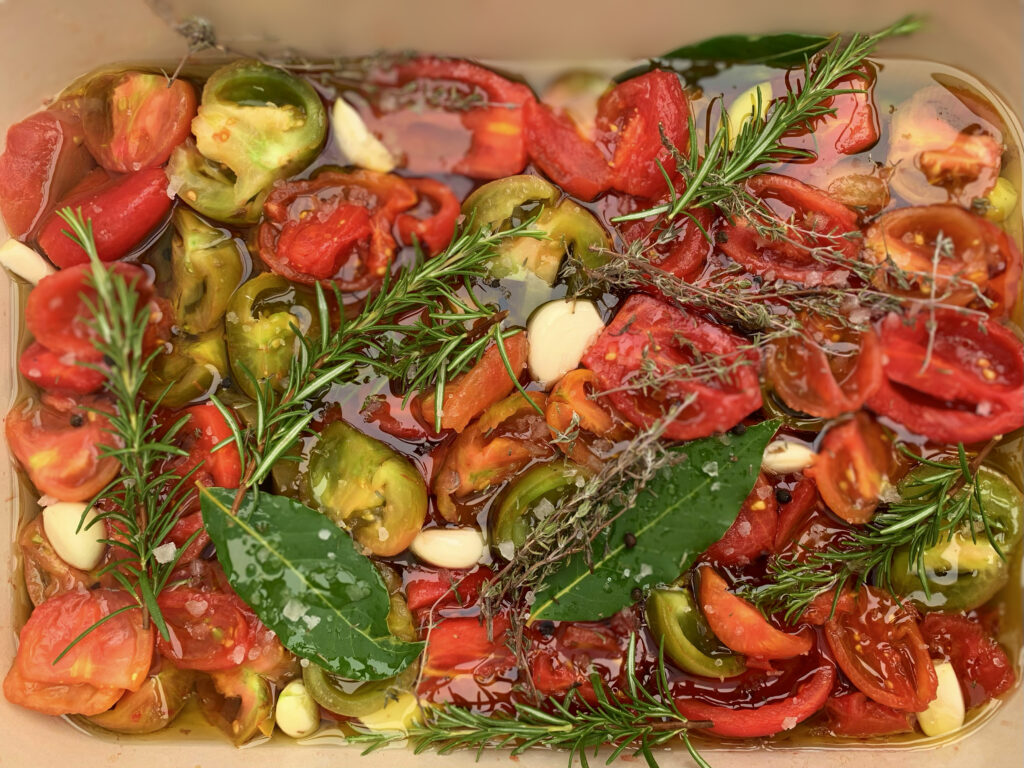
For this you will need:
- 2kg medium-sized tomatoes
- 6 fresh rosemary sprigs
- 8 fresh (or dried) thyme sprigs
- 12 black peppercorns (whole or ground)
- 4 dried bay leaves
- 8 medium garlic cloves, peeled
- 2 tsp sea salt
- 3 tbsp sugar
- 500ml extra virgin olive oil
Optional: Substitute 500g of tomatoes with red peppers (skinned and seeded) when available.
Remove any stalks and cut a small cross at both ends of each tomato. Place them in a pan or heatproof bowl and cover with boiling water. Let them sit for 5–6 minutes, then drain and peel. Discard the skins or set them aside for a quick tomato sauce.
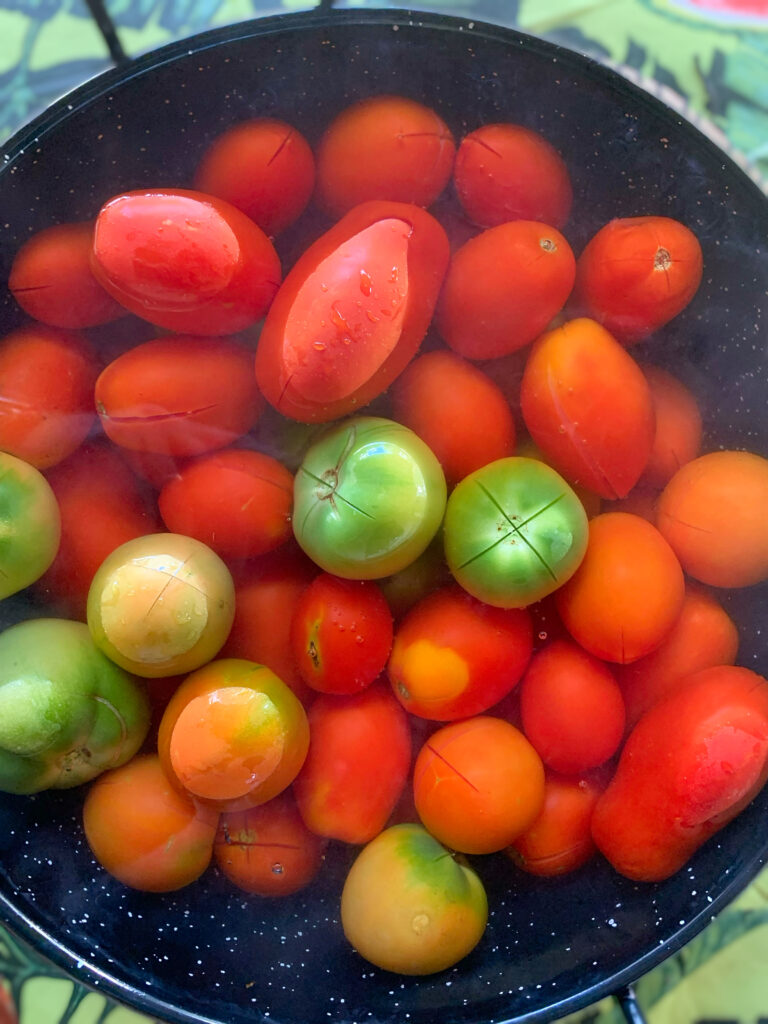
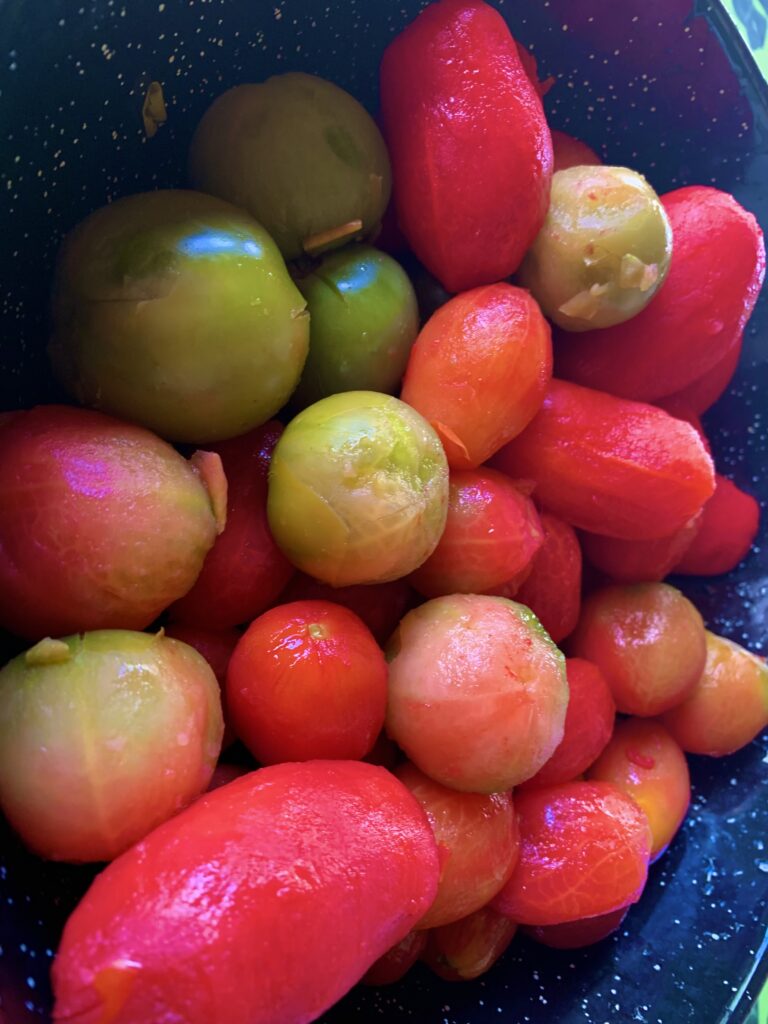
Peel the tomatoes, starting from the bottom. If some skin remains, it’s fine. Slice the tomatoes in half and remove the seeds either using a teaspoon or, in this case, by gently massaging them out with your fingers.
Tightly pack the tomatoes, cut side up, in a roasting tin. Add the sprigs of rosemary, thyme, bay leaves, and garlic in between the tomatoes. To release more flavour from the garlic, press down on the cloves with the side of a knife or your palm.
Season the tomatoes generously with sea salt and black pepper, and sprinkle the sugar evenly. Pour over the olive oil, making sure to cover the tomatoes. Press down gently with the back of a fork to allow the oil to fill the insides of the tomatoes.
Preheat the oven to 80°C (fan-assisted) or 100°C (gas oven). If using a gas oven, cover the tin with foil and remove it an hour before the end of cooking. Cook the tomatoes for 2½–3 hours, until they are translucent and soft with golden edges.
Remove the rosemary, thyme, and bay leaves. While the oil is still hot, spoon the tomatoes into sterilised jars and top with the infused oil. Seal the jars and store in a cool, dark place. Once opened, refrigerate. The oil will solidify in the fridge but will return to liquid at room temperature.
Variations:
To add a smoky flavour, cook the tomatoes uncovered for the first two hours. This works particularly well if using red peppers, which should be charred under the grill to remove their skins. A spoonful of the “burnt” confit adds a delicious smokiness to sugo, perfect for autumn and winter when the air is filled with the scent of burning olive wood.
Yield:
This recipe typically fills 3 x 500g jars, with seasoned oil left over. The leftover oil can be flavoured with herbs and used as a drizzle for pizza or added to sauces.
Waste Not, Want Not: Quick Tomato Sauce
In the Puglia Kitchen little goes to waste. The discarded tomato skins and seeds from the confit can be turned into a easy tomato sauce.
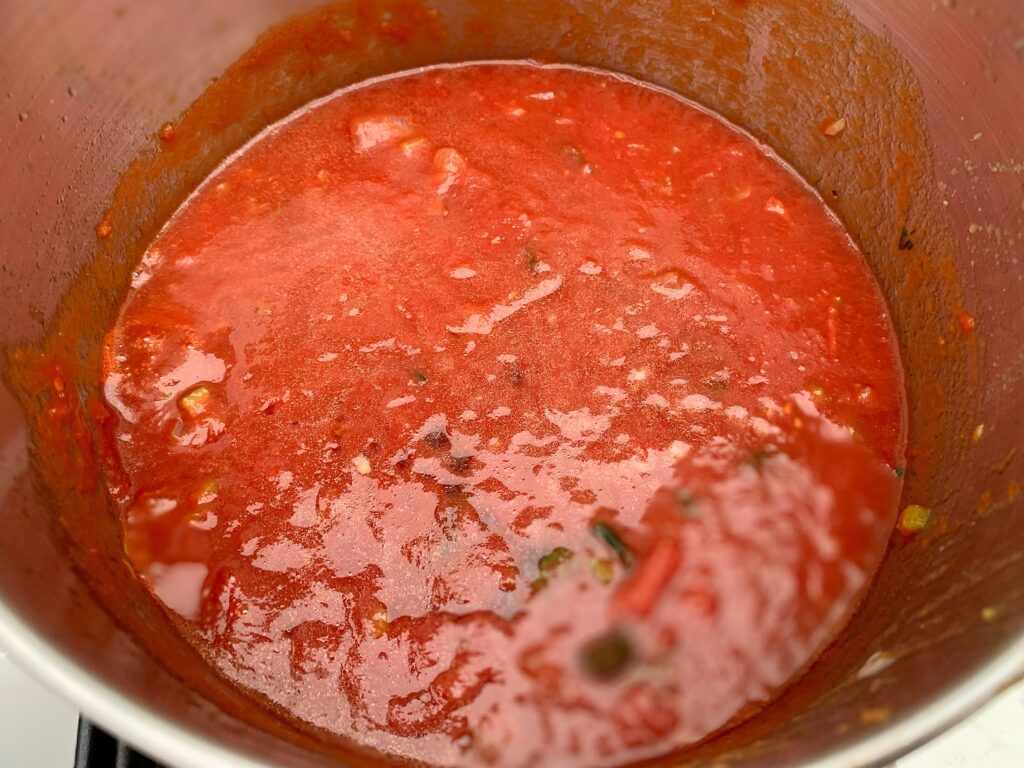
For this you will need:
- Olive oil (preferably leftover from the confit)
- 2–3 anchovy fillets
- 1 onion (optional), roughly chopped
- Tomato skins, seeds, and juice
- Herbs of choice
- Red wine or balsamic vinegar
- Salt and pepper to taste
Method:
- Prepare the Sauce:
Heat some olive oil in a pan and melt the anchovy fillets. If using, sauté the onion until soft. Add the tomato skins, seeds, and juice, along with any herbs you prefer. Drizzle in some red wine or balsamic vinegar. - Simmer and Reduce:
Let the sauce simmer for 30–40 minutes, allowing it to reduce. Pass the sauce through a sieve or use a rotary mill to smooth it out. - Finish and Serve:
Stir in more olive oil (using the leftover confit oil if available) and use the sauce for your next plate of pasta. Alternatively, this sauce is perfect for slow-cooking involtini or polpette.

